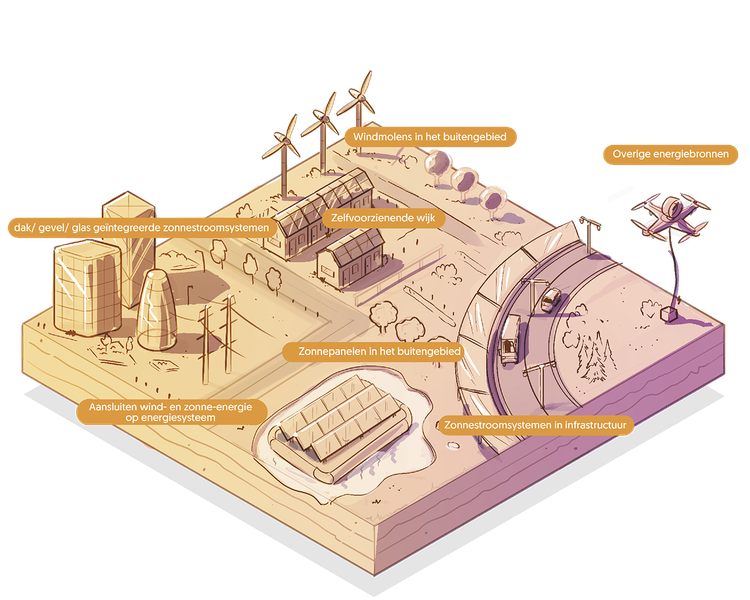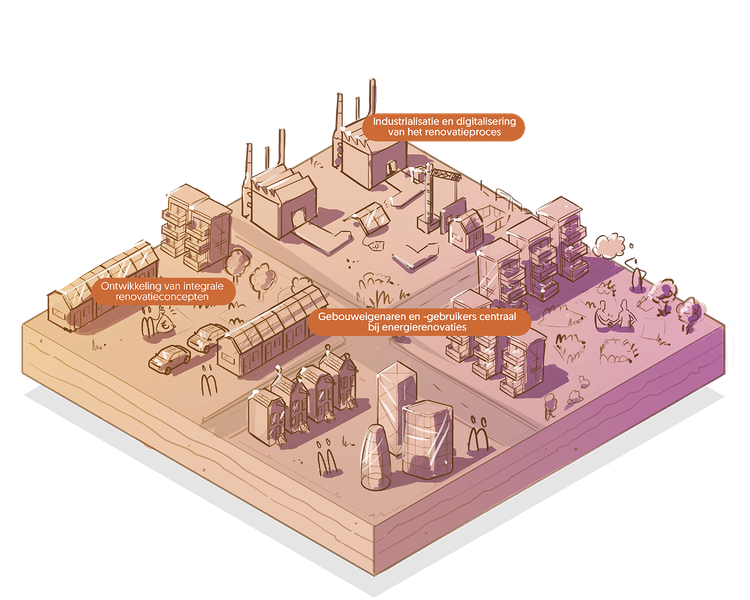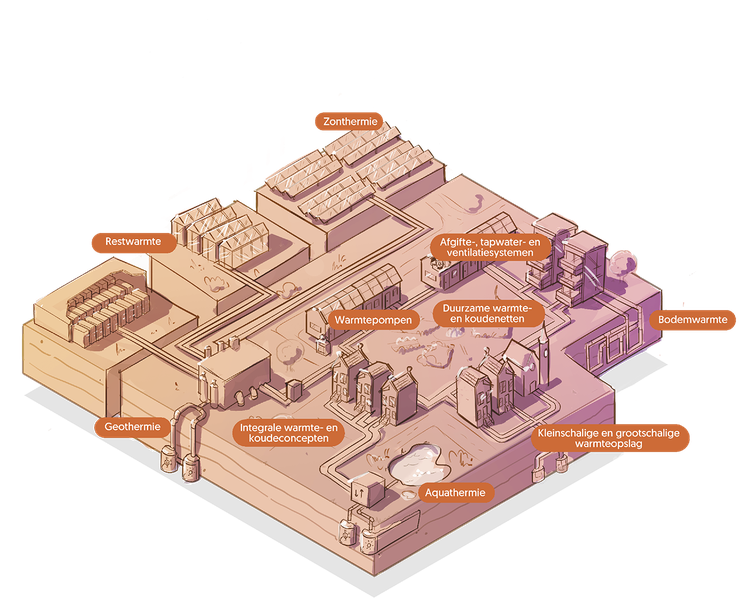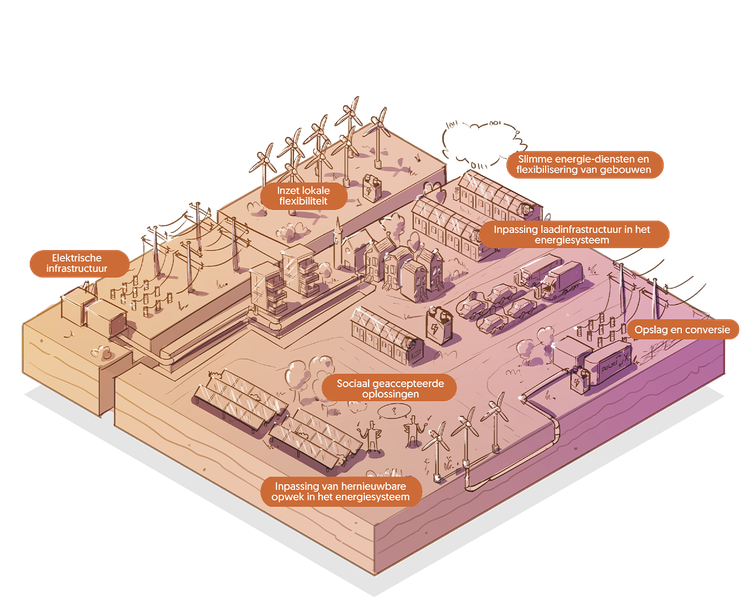However, non-technological solutions are also needed, such as ensuring the acceptance and engagement of citizens and businesses in the transition of the energy system.
Four of the Meerjarige Missiegedreven Innovatieprogramma’s (MMIP’s) focus on topics related to the built environment
- MMIP 2: Hernieuwbare elektriciteitsopwekking op land en in de gebouwde omgeving (pdf)
- MMIP 3: Versnelling van energierenovaties in de gebouwde omgeving (pdf)
- MMIP 4: Duurzame warmte en koude in de gebouwde omgeving (pdf)
- MMIP 5: Elektrificatie van het energiesysteem in de gebouwde omgeving (pdf)
Developments from other sectors also have an impact on the challenges faced by the built environment. For example, mobility, sustainable electricity generation, and the utilization of waste heat from the industry.
Meer weten?
Built Environment
-
Electricity plays a central role in the sustainable energy supply of the future. It is often referred to as the new "primary fuel." One of the objectives of the Climate Agreement for renewable energy generation on land and in the built environment is a minimum of 42 TWh by 2030 (at least 35 TWh from large-scale systems and at least 7 TWh from small-scale systems in the built environment). This corresponds to 35% of the total current annual consumption and implies an almost quadrupling of electricity generation from wind turbines and solar power installations. Strong further growth is expected for the period leading up to 2050 and beyond.
The Netherlands has ample space for wind and solar energy on land and in the built environment. However, the actual realization depends on various innovations, such as:
- The required technologies for large-scale production of wind and solar power on land are available but can still further innovate in terms of costs, yields, and application possibilities.
- Innovations in the market and policy domain to combine low costs with high societal value.
- Functional and aesthetic integration of solar power systems in the built environment.
- Spatial and ecological quality as important considerations when applying solar power systems in rural areas (land, infrastructure, and water).
- Technological and application innovations supporting the deployment of land-based wind energy while maintaining societal enthusiasm.
- Integration of large quantities of electricity from sustainable sources into the future energy system with special attention to the limited capacity of the electricity grid.
We continuously seek new sources for sustainable electricity generation (in addition to solar and wind) on land and in the built environment.
-
The challenge is to transform over eight million homes and one million commercial buildings into well-insulated properties that are heated with sustainable heat and powered by clean electricity by 2050. This requires technical, procedural, and societal innovations. MMIP 3 focuses on achieving integrated solutions that address the following three aspects:
- Development of integrated renovation concepts for homes and commercial buildings.
- Industrialization and digitization of the renovation process.
- Putting building owners and users at the center of energy renovations.
Affordable and attractive renovation concepts are being developed for key building types, particularly those that contribute significantly to CO2 emissions. Efficiency in this acceleration can be achieved through the industrialization and digitization of the production, construction, and installation processes.
Moreover, the technical and procedural innovations need to align with the needs of building owners and users. After all, they are the ones who ultimately decide to renovate. With these arrangements, scaling, and user-focused approach, efficiency improvements can be achieved, leading to lower system costs by 2030. This will make renovation cheaper, easier, and more appealing within a short period of time.
-
The joint goals of the Climate Agreement and the Coalition Agreement aim to achieve a CO2 emission reduction of 10.4 Mton in 2030 (compared to 1990) for the built environment. A significant portion (about a quarter) of the final energy consumption in the Netherlands is used for heating the built environment. One of the biggest challenges for the Dutch energy transition is to decarbonize the heat supply for existing buildings. MMIP4 outlines several pathways to achieve the goals of the agreements:
- Renovation concepts based on insulation combined with electrification, using heat pumps, ventilation systems, and small-scale heat storage. This is considered an individual approach to sustainable heating.
- Development of collective heating and cooling networks with sustainable heat sources such as geothermal energy, ground source heat, aquathermy, solar thermal, and waste heat, combined with seasonal heat storage.
- Different combinations of individual and collective heat solutions involving (very) low-temperature heat networks and building measures for space heating, hot water, and/or heat storage.
Therefore, the goals of the agreements are pursued through different pathways. MMIP4 identifies seven sub-programs that contribute to these goals. The sub-programs are:
- Heat pumps
- Distribution, hot water, and ventilation systems
- Small-scale heat storage
- Sustainable heating and cooling networks
- Large-scale heat storage
- Geothermal energy
- Low-temperature heat sources
With the innovations described in MMIP4, property owners, municipalities, and homeowners have increasingly better options to transition to sustainable heating and cooling for any type of building, neighborhood, or business park. To implement the necessary developments outlined in the sub-programs, intensive collaboration is required among innovators, municipalities, energy companies, construction and installation sector, knowledge institutes, and building owners. By jointly innovating from diverse perspectives, we can achieve the goal of realizing a CO2-free built environment by 2050.
-
The electrification of the energy system in the built environment is putting increasing pressure on the electricity grid. Without innovation, the energy transition will face limitations such as the physical and financial constraints of grid expansion, limits to supply security, and the affordability of the electricity system. Innovation is possible in various areas, including buildings, electric charging infrastructure, generation, storage, and conversion of sustainable electricity, demand-response integration, and digitalization of control systems. The new energy system will have a more bottom-up character, giving end-users the opportunity to play an active role in the energy system. Innovative solutions can only succeed when they are embraced and accepted by users. This MMIP focuses on three objectives:
- Scalable solutions for a well-functioning electricity system in the built environment, considering the local context, other energy carriers in the built environment, and the connection to the (inter)national energy system.
- Solutions that empower end-users to have control over how and where they meet their sustainable energy needs, taking into account the context of the local energy system.
- A flexible electricity capacity of and for the built environment by 2030.
-
- The societal support to address the climate problem seriously
- The development of a European manufacturing industry for circular and high-efficiency solar cells and panels
- Innovations that accelerate the global energy transition
-
- Integration of renewable energy generation into the energy system of the future
- Developing the right solutions to maintain societal support Scaling up
- innovations fast enough to achieve climate goals on time
-
- Digitalization
- Industrialization and process optimization
- Collaboration along the value chain
- Performance guarantees
-
- Circularity
- Labor productivity / Capacity
- Attractive offering
- Financing and cost neutrality of housing
-
- The optimal utilization of locally available heat and cold sources
- Incorporating cooling in the heat transition to prepare for climate change
- Large-scale heat storage in summer for use in winter
-
- The enormous scaling required for the sustainability of buildings
- Timely availability of new technologies
- Achieving cost reduction for an acceptable price level
- The societal challenge of engaging society in the heat transition
-
- Digitization of the electricity system
- Storage and conversion are developing rapidly and prices are decreasing
- Flexible control of energy demand from heat pumps and charging stations
-
- Peak load on electricity infrastructure due to decarbonization of heat demand and mobility
- Mismatch in timing between demand for and supply of renewable energy
- Technical solutions with social acceptance and adaptation of institutional frameworks




